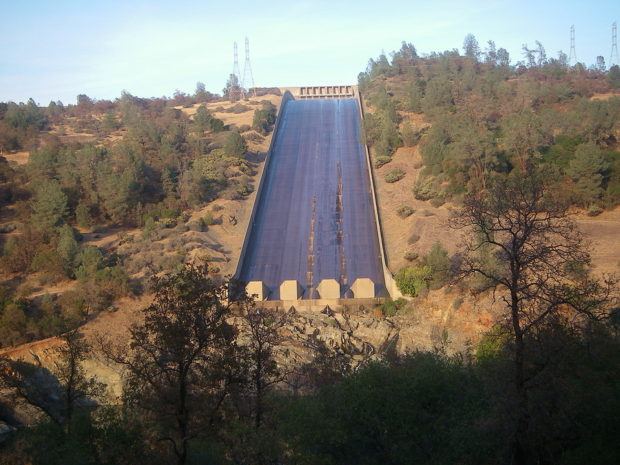A crippled spillway is threatening to submerge an entire region of northern California after a recent deluge of rain. And the state’s power market may already be feeling it.
As state officials rush to repair an emergency spillway for the Oroville dam — just 150 miles (241 kilometers) north of San Francisco — an 819-megawatt hydropower plant, capable of supplying about 600,000 homes with electricity, remains shut there. That’s the equivalent of two natural gas-fired power plants that will need to kick into gear elsewhere in California to make up for the lost supplies, according to Bloomberg New Energy Finance.
Almost 200,000 people have been forced to evacuate as the damaged spillway threatens to flood an area that’s also home to about a dozen power plants, based on data compiled by Bloomberg New Energy Finance. The boost in gas demand resulting from their shutdown would come just as California’s supplies of the power-plant fuel are constrained. The Aliso Canyon gas storage field outside of Los Angeles has been closed since a massive leak in late 2015, and operators are still waiting for permission from the state to restart.
“Gas generation probably needs to pick up the slack from what you lose at the Oroville Dam,” said Het Shah, an energy analyst at BNEF. “You need two gas facilities to fill in that gap.”
On Monday, wholesale gas at the PG&E City Gate hub in Northern California was at a five-year high for the date, trading at a premium of 39 cents above the U.S. benchmark Henry Hub, data compiled by Bloomberg show.
Two 230-kilovolt power lines in the area have also been de-energized, said Steven Greenlee, a spokesman at California ISO, which oversees the region’s power grid. No other problems have occurred on the grid in relation to the dam, Greenlee said.
“Just like with any transmission outage, we re-optimized the grid and found alternative routes,” he said.
The Oroville plant closure comes at a time of low seasonal demand for natural gas in California. Temperatures in the state have climbed after a cold spell earlier in the winter, reducing use of the heating fuel.
The threat of flooding at Oroville meanwhile may remain through the week. Governor Jerry Brown declared a state of emergency on Sunday to mobilize resources and support evacuations.
A storm is forecast to arrive in the Pacific Northwest and then settle down into California, Andrew Orrison, a forecaster with the U.S. Weather Prediction Center in College Park, Maryland, said. By Thursday and Friday, the entire state may be hit with heavy rain and snow.
“This will not be good news for the situation,” he said, “as far as the Oroville dam.”





















 What to Expect in 2026: U.S. P/C Results More Like 2024
What to Expect in 2026: U.S. P/C Results More Like 2024  A Practical Blueprint: The Five Plays of an Innovation Culture
A Practical Blueprint: The Five Plays of an Innovation Culture  AIG Partners With Amwins, Blackstone to Launch Lloyd’s Syndicate Using Palantir
AIG Partners With Amwins, Blackstone to Launch Lloyd’s Syndicate Using Palantir  Odometer Fraud Sees 14% Jump in the Past Year
Odometer Fraud Sees 14% Jump in the Past Year 



